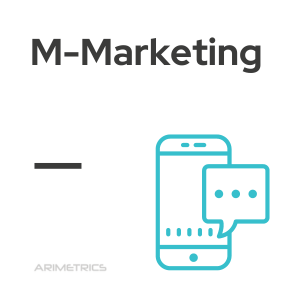 Definition
Definition
M-Marketing or Mobile Marketing is a marketing strategy that is currently used to reach consumers through their mobile devices. It has become a very effective channel for businesses because most of the population owns a mobile phone and carries it with them all the time.
M-Marketing encompasses a wide variety of tools, such as SMS (text messaging), mobile applications, push notifications, mobile advertising and social networks. In addition, it allows segmenting the target audience better than other advertising media, which increases the effectiveness of advertising campaigns.
Types of M-Marketing
There are several types of M-Marketing that businesses can use to reach their potential customers effectively. Below are some of the most common:
- Text Messaging (SMS): Texting is a simple and effective way to reach customers directly on their mobile devices. Promotions, special offers or relevant information about products or services can be sent. In addition, text messages have a 98% open rate, which means that most recipients will read them.
- Mobile applications: Those are a powerful way to reach customers in a more interactive and personalized way. Businesses can use apps to send personalized push notifications with special offers to retain existing customers and attract new ones. They can also offer exclusive content and entertainment to keep users engaged and engaged with the brand.
- Push notifications: Alerts that are sent directly to users’ mobile devices. Businesses can send notifications with relevant information, promotions, and other special offers to keep their customers interested in the brand.
- Mobile advertising: Mobile advertising refers to online advertising displayed on mobile devices, such as banners, text ads, or videos. You can opt out of advertising on third-party mobile applications or on the company’s own mobile content. With mobile advertising, businesses can reach a wider audience and be more visible in the marketplace.
- Social networks: They are a very effective tool for M-Marketing. Companies can use platforms such as Facebook, Instagram or Twitter to promote their products or services, create interesting content and maintain a dialogue with their customers. Social media also allows businesses to reach a wider audience and create communities of loyal followers.
Advantages of M-Marketing
Among the benefits of M-Marketing we can highlight:
- Effective reach: Mobile Marketing allows companies to reach consumers anytime and anywhere, since the majority of the population owns a mobile device and carries it with them constantly. In addition, advertising campaigns can be segmented to target specific audiences, which increases the effectiveness of the marketing strategy.
- Interactivity: Mobile applications allow companies to interact in a more personalized way with their customers. Through personalized push notifications, businesses can send special offers and promotions to retain existing customers and attract new ones. In addition, businesses can offer exclusive content and entertainment through the apps, which helps keep users engaged and engaged with the brand.
- Measurement of results: M-Marketing allows companies to measure the results of their advertising campaigns more accurately than other advertising media. Mobile apps and online ads have built-in analytics tools that allow businesses to measure the number of app installs, how often push notifications are opened, and sales conversions.
- Lower costs: Compared to traditional advertising, M-Marketing is usually more profitable. Businesses can reach a wider audience through third-party mobile apps or social media without needing to spend heavily on advertising. In addition, it is not necessary to produce printed materials or pay for advertising space on television or print media.
- Customer loyalty: M-Marketing allows companies to maintain a constant relationship with their customers. Push notifications, mobile applications and social networks facilitate communication between the company and its customers. In addition, special offers and promotions just for customers increase brand loyalty and engagement.
Examples of M-Marketing
Here are some examples of how well-known brands have used M-Marketing to connect with their customers:
- IKEA and Augmented Reality (AR): IKEA launched the “IKEA Place” app, which allows users to visualize how furniture would look in their homes using augmented reality technology. This helps customers make more informed purchasing decisions by being able to see products in a realistic environment before buying.
- Nike and gamification: Nike developed the“Nike Run Club” app, which turns exercise into an interactive experience. The app offers challenges, progress tracking and rewards, incentivizing users to stay active and engaged with the brand.
- Burberry and live streaming on social media: Burberry has used Instagram Live to broadcast fashion shows in real time. During these events, viewers can purchase products directly from the stream, creating an immersive and exclusive shopping experience.
- Sephora and chatbots: Sephora implemented a chatbot on Facebook Messenger that helps customers book services, find products and receive personalized recommendations. This enhances the customer experience by providing instant and personalized assistance.
